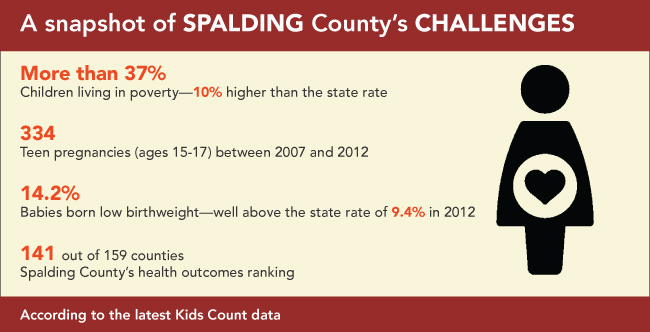Connecting Moms-to-Be with Healthy Lifestyles in Spalding County
Print This Post
BY DIANA ST. LIFER
Picturesque is one way to describe Spalding County, where serene lakes, scenic parks and historical landmarks can be found as readily as local parades and a bustling downtown.
The conditions for children and families who live there, however, paint a different landscape of this 200-square-mile county that nearly 64,000 residents call home.

The challenge Spalding County Collaborative Authority for Families and Children is adamant about facing is to decrease the number of low-birthweight (LBW) babies.
“It’s a struggle to help people understand the importance of prenatal care,” said Molli Pruitt of the Spalding County Health Dept., who is responsible for overseeing the grant for the LBW initiative. “There’s a disconnect among women with the need for prenatal care.”
To help make that connection, the Georgia Family Connection Collaborative is partnering with other social and healthcare agencies to provide mothers-to-be with information and education about healthy lifestyles and pregnancies. Within the past year, Spalding’s LBW initiative has reached more than 1,000 residents.
Perhaps it’s because the programs and activities are varied and far-reaching. From outreach to mothers of LBW babies in the hospital and educational lessons for teen parents, to a daylong Healthy Children Conference, these strategies are beginning to connect women to prenatal care.
“It’s a multi-pronged approach we take to get the word out to our residents,” Pruitt said. “It’s a blending of support and delivering information to our prenatal and postnatal moms.”
Just as important are all the points of contact. For example, from the moment a woman enters the Health Dept. to sign up for presumptive eligibility for Medicaid, she receives a Healthy Children bag filled with resources for having a healthy pregnancy. From July 1, 2013, through May 21, 2014, the Health Dept. served 525 pregnant women.
At that point, Pruitt says, local health professionals capture vital information like whether an expectant mother smokes, if there is a history of substance abuse, and what level of stress she may be experiencing.
“We call them to see how their pregnancy is progressing and to reinforce the LBW message,” said Pruitt. “We encourage them to keep their prenatal doctor appointments and to keep their stress level low.”
New mothers are also visited in the hospital, and Spalding offers in-home visits, although Pruitt says not many mothers who qualify take advantage of the opportunity.
Through the WIC program, the county holds a Healthy Connections Group where pregnant women can meet monthly to share their experiences and concerns, and continue to receive education about ensuring a healthy pregnancy, breast feeding, and raising a healthy child. Lisa Smith of Griffin was a regular member of the group during her second pregnancy.
“It was a great opportunity to be around other moms and talk about our frustrations and how we were handling stressful situations,” said Smith, 25, the mother of 4-year-old Winter and 1-year-old Anneliese. Smith said she also learned about proper nutrition, the risks of alcohol and substance abuse during pregnancy, and child development, among other topics.
It was through the group that Smith learned about the Healthy Children Conference and Expo held in April 2014. The free, daylong event featured experts who spoke about a variety of topics related to raising healthy children.
Kim Stephens, chair of the Healthy Children Strategy Team, located at Spalding Regional Hospital, works to link the community with the hospital. “Our goal is to reach as many new moms in our community as possible,” she said, adding that representatives from the Health Dept. and WIC will come to the hospital to speak with new mothers.
The challenge now, Stephens says, is to keep the effort going as funding ends. “We need to figure out how to do this moving forward with little or no funding,” she explained. “We want to keep this going the best we can. Our goal is to try and touch as many new moms in the community as we can. More than focusing on decreasing the low-birthweight rate is increasing the understanding of low-birthweight prevention. That is, for sure, the focus.”
Diana St. Lifer is a professional writer with more than 25 years’ experience. She holds a bachelor’s degree in communications, a post-B.A. certificate in child advocacy, and is a certified professional life coach who specializes in teen and adolescent issues.
When it comes to raising a community of healthy children, Spalding County Collaborative Authority for Families and Children understands that it takes a village. Indicators of child well-being are seldom addressed in a vacuum. Tackling a single challenge, such as low birthweight, requires an understanding of other equally challenging issues.
Read “It Takes a Village to Raise Low Birthweight Rates.”
Low birthweight, childhood obesity, and a literacy gap are serious threats to the well-being of Georgia’s families and children. Recognizing the impact these pressing issues have on the state’s health, safety, and ability to prosper, Georgia Family Connection Partnership has launched three initiatives dedicated to developing and implementing strategies that address these key indicators.
